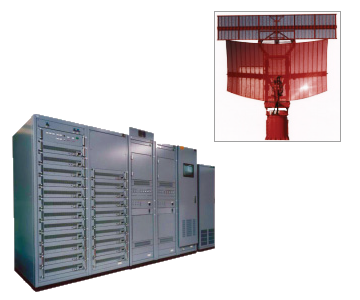ASR 2000
Description of the radar set, tactical-technical characteristics

Figure 1: ASR 2000 Airport Surveillance Radar

Figure 1: ASR 2000 Airport Surveillance Radar
| Specifications | |
|---|---|
| frequency: | 2.7 to 2.9 GHz (S-Band) |
| pulse repetition time (PRT): | between approx. 0.9 and 1.1 ms |
| pulse repetition frequency (PRF): | 1000 pps |
| pulsewidth (τ): | 0.8 µs / 60 or 80 µs |
| receive time: | |
| dead time: | |
| peak power: | up to 32 kW |
| average power: | |
| instrumented range: | 60 or 80 nmi (110 or 150 km) |
| accuracy: | 60 m / 0.12° |
| range resolution: | 210 m / 2,3° |
| accuracy: | |
| beamwidth: | 1.5° |
| hits per scan: | |
| antenna rotation: | 15 rpm |
| MTBCF: | |
| MTTR: | |
ASR 2000 Airport Surveillance Radar
The ASR 2000 is a highly cost effective airport surveillance radar (ASR) for air-traffic control, providing aircraft position information coverage within Terminal Maneuvering Area (TMA) and within a radius of 60 or 80-nmi around the airport. The ASR 2000 was developed as a successor to the conventional ASR 8 and ASR 9 with klystron-tube transmitter. It uses a multi module solid-state transmitter with graceful degradation with a pulse power option of 8, 16 or 32 kW and an operational duty cycle of 6 percent. The exciter is a digital synthesized type. System architecture and design using the most modern COTS equipment (Commercial Off The Shelf) with high performance and availability. The ASR 2000 is designed in totally modular construction with the integration functional modules in separate physical units. It provides easy training and maintenance and low logistic cost during its functional life time.
The ASR 2000 uses two redundant wide dynamic range receivers with digital pulse compression and adaptive moving target detection. The dynamic linear range is better than 65 dB, and the pulse compression ratio is 18.75 dB. A linear and a logarithmic IF-amplifier work in parallel. The subclutter visibility is 57 dB.
The double curvatured parabolic reflector antenna makes a cosecant-squared antenna pattern with a very low size of side lobes (–28 dB). There are feed horns for high and low beam pattern. The antenna gain in high beam pattern is 32 dB; and in low beam pattern 32 dB;. The polarization may be vertically linear or circular. An LVA antenna is co-mounted with the primary radar antenna. The ASR 2000 meets ICAO ATC specification.
